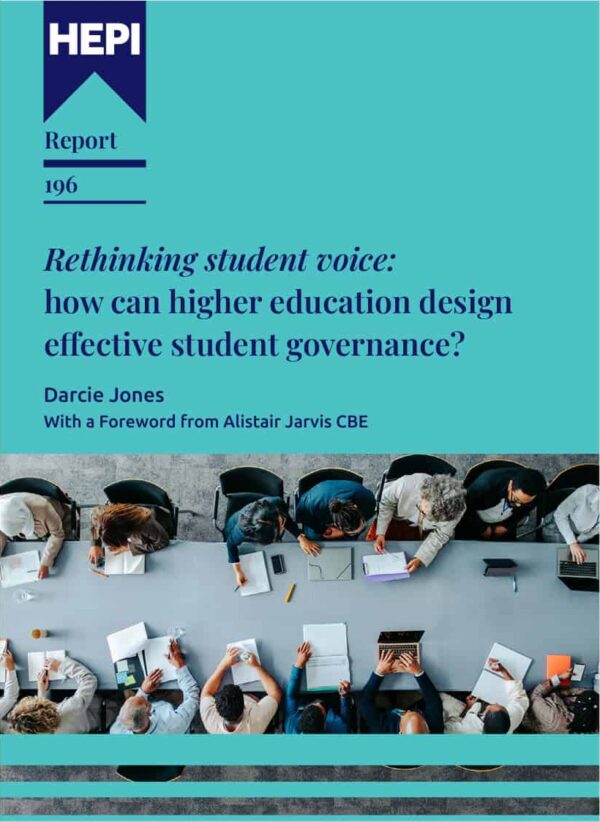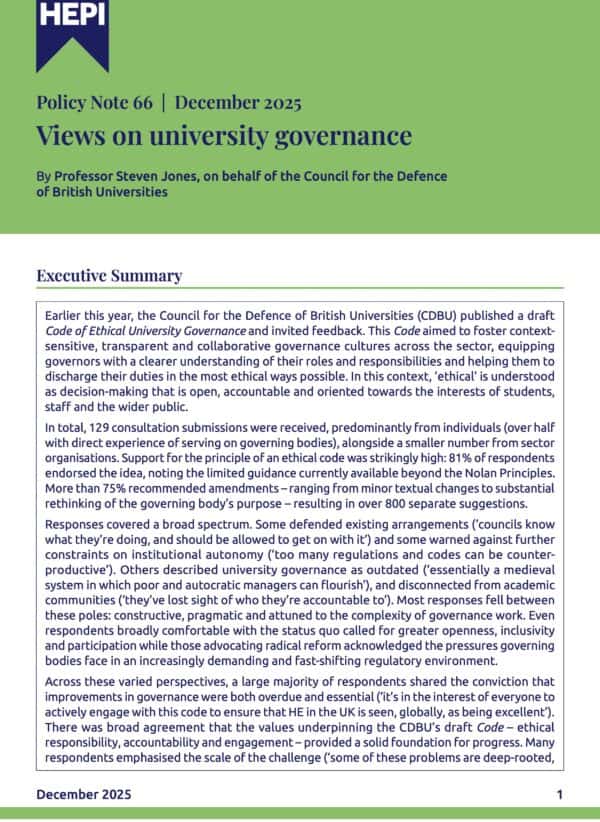New Government, familiar problems – By Chris Husbands
The blog below has been kindly written for HEPI by Professor Sir Chris Husbands, who is a Director of Higher Futures and a HEPI Trustee. He was previously the Vice-Chancellor of Sheffield Hallam University.
On Friday, Times Higher Education ran the thoughts of Nick Hillman, HEPI’s Director, on what the geography of Whitehall might mean for higher education at the spending review and, over the weekend, Bright Blue ran Nick Hillman’s latest article on student migration.
The higher education sector had high hopes of a new government last July. Early messaging from ministers suggested that they were justified. The Guardian quoted Peter Kyle, the Science Secretary, declaring an ‘end to the war on universities’. Speaking to the Commons in September 2024, the Education Secretary Bridget Phillipson said that ‘the last Government ..use[d] our world-leading sector as a political football, talking down institutions and watching on as the situation became…desperate. I [want to]…return universities to being the engines of growth and opportunity‘. In November, she announced a rise – albeit for just one year in the first instance – in the undergraduate tuition fee, with the prospect of alleviating pressure on higher education budgets.
Ten months on, the hopes look tarnished as financial, political and policy challenges mount. The scale of the higher education funding challenge is deepening, it seems, by the week. The OfS has reported that four in ten universities will report a deficit this year. Restructuring programmes are underway in scores of universities, with some institutions on their second, third or even fourth round of savings. The post-study graduate visa, an important lifeline for international student recruitment, appears to be under threat.
There are eerie echoes of headlines and comments under the last government. The Daily Telegraph declared that a ‘record number of universities [are] in deficit’. The Times claimed that universities that appeared to report relatively poor progression to graduate-level jobs were to be ‘named and shamed’. Following the success of Reform UK in local elections, some backbench Labour MPs have been sharply critical of universities: ‘I would close half our universities and turn them into vocational colleges’, wrote the Liverpool MP Dan Carden (BA, London School of Economics, since you ask), whilst Jonathan Hinder, MP for Pendle (MA Oxford) declared himself ‘happy to be bold and say I don’t think we should have anywhere near as many universities and university places‘. Philip Augar, who reviewed skills funding for Theresa May’s Government, wrote in the Financial Times that the ‘English higher education market is broken‘ as a result of a ‘failed free market experiment’. It seems terribly familiar: a sector in financial crisis, losing political traction and friends.
Policy direction appears to be unclear. The English higher education sector is still largely shaped by the coalition government’s policy decisions between 2010 and 2015. Its key design principles include uncapped student demand since number controls were abolished in 2013, assumed cross-subsidies across and between activity streams allowing for institutional flexibility, access to private capital markets since HEFCE capital funding was removed in 2011, diverse missions but largely homogenous delivery models based around traditional terms and full-time, three-year undergraduate provision, and jealously protected institutional autonomy. Familiar though these principles are in higher education policy, some are in truth relatively recent, and are creating tensions between what the nation wants from its university system, what universities can offer and what the government and others are willing to pay for.
Moreover, the sector we have in 2025 is not the sector which the 2017 Higher Education and Reform Act (HERA) envisaged: HERA was expected to significantly re-shape the sector. The government’s impact assessment of HERA suggested that there would be in the order of 800 HE providers by the mid-2020s. This did not happen, though the impact of private capital, often channelled through established institutions and now rapidly growing for-profit providers, should not be underestimated as a longer-term transformative force in the sector.
We are expecting both a three-year comprehensive spending review and a post-16 White Paper in a couple of months’ time. In my 2024 HEPI paper, ’Four Futures’, I sketched out possible scenarios for a sector facing intense challenges. The near-frozen undergraduate fee was reducing the unit of resource for undergraduate teaching as costs rose. Undergraduate demand seemed to be softening amongst (especially) disadvantaged eighteen-year-olds. International student demand remains volatile and subject to political change in visa regulations. The structural deficit on research funding deepened. ‘Four Futures’ outlined four scenarios, summarised in Table 1.
Of course, we all want a mixture of cost control, thriving universities, regional growth and research excellence, but it is difficult to have all of them. Governments and universities set priorities based on limited resources, so there are choices to be made and trade-offs to be confronted for both policymakers and institutional leaders.
Government needs to make decisions about universities in the context of competing and changing policy imperatives. It needs to balance restoring government finances, allocating resources to other needy sectors, securing economic growth, and, more obviously important than a year ago, protecting sovereign intellectual property assets and growing defence-related R&D. The Secretary of State’s letter to Vice-Chancellors in the Autumn identified growth, engagement with place, teaching excellence, widening participation and securing efficiencies, but did not unpick the tensions between them. That depends on articulating a stronger vision for higher education given the Government’s priorities and resources and the economic challenges facing institutions, and it is a task for the forthcoming White Paper.
But there are urgent choices too for institutions, and those need to be made quickly in many universities. Institutional and sector efficiencies are vital, and a key theme of the UUK Carrington Review, but they need to be considered in the light of sustainable operating models for both academic delivery and professional services. Institutions need a clearly articulated value proposition, communicated strongly and effectively and capable of driving the operating model. In the past, too many universities have tried to do too many things – and with resources scarce, the choices cannot be ducked. That means there is a consideration which links the choices facing government and those facing individual institutions. If a core strength of the English system lies in its diversity and its distributed excellence, individual institutions need to think about their place in, and responsibilities to, the wider HE system. For a sector characterised by intense competition, that is a profound cultural shift, notwithstanding the economic and legal challenges of collaboration.
The higher education sector now is not the sector we have always had, and therefore it won’t be the sector we always have. How the sector collectively, and institutions individually, confront choices is a test for policymakers and institutional leaders.







Comments
Samuel Cameron says:
I would say if a fee increase was going to be made it should be carried out after a national
restructuring. If the very very failing institutions find themselves bailed out when they have just axed lots of staff and programmes, I suspect it would lead to them wasting more money not putting their house in order. There are certain VCs who have a very high preference for buildings and hobby horse ego trips over actual quality of delivery and
should not be given more money out of the blue after a series of badly managed cheese paring style cuts. On a Darwinian basis you might want to eliminate institutions which have shown the most disastrous and charter violating modes of handling their debts.
Reply
Add comment